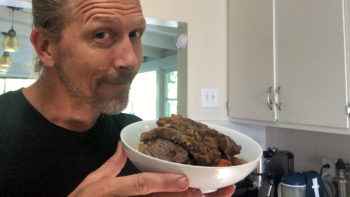Fall is here and the time for long, slow braises has arrived. Braises that fill the house with mouthwatering aroma for hours and leave your belly filled with rich, warm and satisfying stews.
This week we’re bringing you a classic—the all-American pot roast.
With just a few hours of hands-off work and some inexpensive ingredients, you can have a meal (or a few meals) that is as delicious as it is Whole Life Challenge compliant!
So check out our video above and the recipe below for a recipe for easy Sunday cooking with leftovers to spare.

All-American Pot Roast
A classic American pot roast. As simple as it is delicious.
Ingredients
- 3-5 lbs. roast (Either chuck roast for something fattier or rump or sirloin for something a bit leaner)
- Kosher salt
- olive oil
- 2 large carrots, 1-2" chunks
- 2 stalks celery, 1" chunks
- 2 onions, peeled and sliced
- 2 T tomato paste
- 2 cloves garlic, minced or grated on a microplane grater
- 4 anchovy filets (optional)
- 1 t red miso (optional)
- small bunch of thyme
- 2 bay leaves
- 1 Q beef or chicken stock
- 1 package Gelatin
- 1 lb. potatoes, 1-2” pieces
Instructions
-
Season meat well all over with kosher salt at least 1 hour before cooking.
-
Preheat the oven to 275 degrees.
-
In a Dutch oven over a medium-high heat, add a small amount of olive oil. When smoking, brown meat 2 ½ - 3 minutes per side until well browned all over. Remove from pot.
-
Add carrots and celery and cook for 6-7 minutes, scraping the brown bits left on the bottom of the pan by the beef. If you need to, add a couple of tablespoons of water to help loosen the bits.
-
When the carrots and celery have some color, add the onions and cook (stirring occasionally) another 5-6 minutes, until the onions are soft and beginning to color.
-
While the onions are cooking, mash together the tomato paste, garlic, anchovy, and miso (if using).
-
Add the stock to a bowl or large measuring cup and sprinkle the gelatin over the surface to hydrate.
-
Add tomato mixture to onions and cook, stirring 1-2 minutes.
-
When the tomato no longer seems raw, add the bay leaves and thyme, return the beef to the pot, and add the stock and enough water to bring the liquid level up to at least ⅔ up the side of the meat.
-
Bring the meat to a simmer, cover with the lid slightly cracked, and place in the oven until tender. (A lean meat may cook 2-3 hours total while a fattier piece might cook 3-4. The meat is done when it offers little resistance when poked with a knife or a skewer.)
-
About 45 minutes before completing the cook, add the potatoes to the pot and return to the oven.
-
When the pot roast is done, you should be able to pierce it easily with a knife or skewer.
-
Remove from oven and let rest in its liquid for an hour.
-
Slice and serve with the vegetables or place in refrigerator for a day (and up to 5 days).
-
To reheat: Remove layer of fat from the top of the liquid, slice the pot roast, and bring some of the broth to a boil in a large skillet. Place the sliced roast in the liquid and heat for 10-15 minutes.
For more recipe ideas like this, be sure to pick up our ALL-NEW 6-week meal plan here. It’s the perfect supplementary resource for the Whole Life Challenge!







